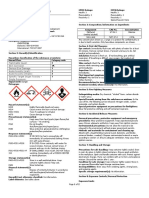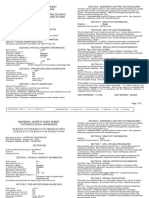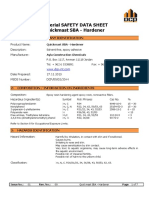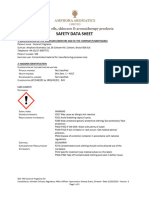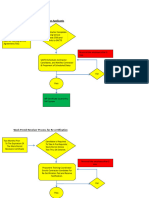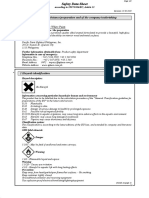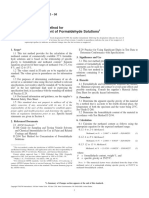EZ Weld
EZ Weld
Uploaded by
Vinith KumarOriginal Description:
Original Title
Copyright
Available Formats
Share this document
Did you find this document useful?
Is this content inappropriate?
Report this DocumentCopyright:
Available Formats
EZ Weld
EZ Weld
Uploaded by
Vinith KumarCopyright:
Available Formats
Export Cleaner
Products
GHS SAFETY DATA SHEET
SECTION I - PRODUCT AND COMPANY
IDENTIFICATION
Product Name: E-Z Weld 733 Low VOC Pipe Cleaner
Product Use: Low VOC Cleaner for PVC, CPVC, ABS and Styrene Pipe &
Fittings
Manufacturer: E-Z WELD Group LLC 1661 President Barack Obama Hwy,
Riviera Beach, FL 33404 USA Tel: 1-561-844-0241 Fax: 1-561-848-8958.
Supplier:
For Emergency: Transportation / Medical Issues: INFOTRAC Tel:
800-535-5053, +1 352-323-3500 (International).
SECTION 2 - HAZARDS IDENTIFICATION
Health
Acute Toxicity: Category 4
Skin Irritation: Category 3
Skin Sensitization: No
Eye: Category 2B
Environmental
Acute Toxicity: None Known
Chronic Toxicity: None Known
Physical
Flammable Liquid: Category 2
GHS Label:
Signal Word: Danger
WHMIS Classification:
Class B, Division 2
Hazard Statements
H225: Highly flammable liquid and vapor
H319: Causes serious eye irritation
H332: Harmful if inhaled
H336: May cause drowsiness or dizziness
EUH066: Repeated exposure may cause skin dryness or cracking
Precautionary Statements
P210: Keep away from heat / sparks / open flames / hot surfaces - No
smoking
P261: Avoid breathing dust / fume / gas / mist / vapors / spray
P280: Wear protective gloves/protective clothing / eye protection / face
protection
P337+P313: Get medical advice / attention
P403+P233: Store in a well ventilated place. Keep container tightly
closed
P501: Dispose off contents / container in accordance with local regulation
SECTION - 3 COMPOSITION/INFORMATION
ON INGREDIENTS
REACH Pre- Concentration
CAS# EINECS# registration Number % by Weight
Cyclohexanone 108-94-1 203-631-1 05-2116297718-25-0000 2-15
Acetone 67-64-1 200-662-2 05-2116297713-35-0000 75-99
All of the constituents of this adhesive product are listed on the TSCA
inventory of chemical substances maintained by the US EPA, or are
exempt from that listing.
* Indicates this chemical is subject to the reporting requirements of
Section 313 of the Emergency Planning and Community Right-to-Know
Act of 1986 (40CFR372).
# indicates that this chemical is found on Proposition 65’s List of
chemicals known to the State of California to cause cancer or
reproductive toxicity.
OUR NAME IS OUR BOND
www.e-zweld.com
SECTION 4 - FIRST AID MEASURES Engineering Controls: Use local exhaust as needed. SECTION 13 - WASTE DISPOSAL CONSIDERATIONS
Monitoring: Maintain breathing zone airborne concentrations below
Contact With Eyes: Flush eyes immediately with plenty of water for 15 Follow local and national regulations. Consult disposal expert.
exposure limits.
minutes and seek medical advice immediately.
Personal Protective Equipment (PPE):
Skin Contact: Remove contaminated clothing and shoes. Wash skin
Eye Protection: Avoid contact with eyes, wear splash-proof chemical SECTION 14 - TRANSPORT INFORMATION
thoroughly with soap and water. If irritation develops, seek medical
goggles, face shield, safety glasses (spectacles) with brow guards and
advice. Proper Shipping Name: Flammable Liquid, n.o.s. (Acetone)
side shields, etc. as may be appropriate for the exposure.
Inhalation: Remove to fresh air. If breathing is stopped, give artificial Hazard Class: 3
Skin Protection: Prevent contact with the skin as much as possible. Butyl
respiration. If breathing is difficult, give Oxygen. Seek medical advice. Secondary Risk: None
rubber gloves should be used for frequent immersion.
Ingestion: Rinse mouth with water. Give 1 or 2 glasses of water or milk to Identification Number: UN 1993
Use of solvent-resistant gloves or solvent-resistant barrier cream should
dilute. Do not induce vomiting. Seek medical advice immediately. Packing Group: PG II
provide adequate protection when normal adhesive application practices
Likely Routes of Exposure: Inhalation, Eye and Skin Contact. Label Required: Class 3 Flammable Liquid
and procedures are used for making structural bonds.
Acute Symptoms & Effects: Marine Pollutant: No
Respiratory Protection: Prevent inhalation of the solvents. Use in a
Inhalation: Severe overexposure may result in nausea, dizziness,
well-ventilated room. Open doors and/or windows to ensure airflow and
headache. Can cause drowsiness, irritation of eyes and nasal passages. Exception for Ground Shipping
air changes. Use local exhaust ventilation to remove airborne
Eye Contact: Vapors slightly uncomfortable. Overexposure may result in DOT Limited Quantity: Up to 1L per inner packaging, 30 kg gross
contaminants from employee breathing zone and to keep contaminants
severe eye injury with corneal or conjunctival inflammation on contact weight per package.
below levels listed above. With normal use, the Exposure Limit Value will
with the liquid. Consumer Commodity: Depending on packaging, these quantities may
not usually be reached. When limits approached, use respiratory
Skin Contact: Liquid contact may remove natural skin oils resulting in qualify under DOT as "ORM-D".
protection equipment.
skin irritation. Dermatitis may occur with prolonged contact. TDG Information
Ingestion: May cause nausea, vomiting, diarrhea and mental TDG Class: Flammable Liquid 3
sluggishness. Shipping Name: Flammable Liquid, n.o.s. (Acetone)
Chronic (long-term) Effects: Defatting dermatitis with prolonged use. In SECTION 9 - PHYSICAL AND CHEMICAL PROPERTIES UN Number / Packing Group: UN 1993
humans, passes the placental barrier, detected in maternal milk. (Based
Appearance: Clear, thin liquid.
on Acetone)
Odor: Ketone. SECTION 15 - REGULATORY INFORMATION
pH: Not Applicable Precautionary Label Information: Highly Flammable, Irritant.
Melting / Freezing Point: -95°C (-139°F) Based on first melting Ingredient Listings: USA TSCA, Europe EINECS, Canada DSL, Australia
SECTION 5 - FIREFIGHTING MEASURES component: Acetone AICS, Korea ECL/TCCL, Japan MITI (ENCS)
Suitable Extinguishing Media: Dry chemical powder, Carbon Dioxide Boiling Point: 56 °C (133 °F) Based on first boiling component: Acetone Symbols: F, Xi
Gas, Foam, Halon, Water fog. Flash Point: -20 °C (-4 °F) TCC based on Acetone Risk Phrases: R11: Highly flammable • R36/37: Irritating to eyes and
Unsuitable Extinguishing Media: Water spray or Steam. Specific Gravity: 0.795 ± 0.10 @ 73 °F ( 23 °C ) respiratory system.
Exposure Hazards: Inhalation and dermal contact Solubility: Solvent portion soluble in water, resin portion separates out. Safety Phrases: S2: Keep out of the reach of children • S9: Keep
Combustion Products: Oxides of Carbon, Hydrogen Chloride and Smoke Partition Coefficient n-octanol/water: Not Available container in a well-ventilated place • S16: Keep away from sources of
Protection for Firefighters: Self-contained breathing apparatus or Auto-ignition Temperature: 465°C (869°F): Acetone ignition - No smoking • S25: Avoid contact with eyes • S26: In case of
full-face positive pressure airline masks. Decomposition Temperature: Not Applicable contact with eyes, rinse immediately with plenty of water and seek
Health: HMIS: 2 • NFPA: 2 • 0-minimal: 1-Slight VOC Content: When applied as directed, per SCAQMD Rule 1171, VOC medical advice • S29: Do not empty into drains • S33: Take
Flammability: HMIS: 3 • NFPA: 3 • 0-minimal: 2-Moderate content is: <25 g/l. precautionary measures against static discharges • S46: If swallowed,
Reactivity: HMIS: 0 • NFPA: 0 • 0-minimal: 3-Serious Odor Threshold: 0.88 ppm (Cyclohexanone) seek medical advise immediately and show this can or label.
PPE: HMIS: B • NFPA: - • 0-minimal: 4-Severe Boiling Range: 56 °C (133 °F) to 156 °C (313 °F)
Evaporation Rate: > 1.0 (BUAC = 1)
Flammability: Category 2 SECTION 16 - OTHER INFORMATION
Flammability Limits: LEL: 1.1% based on Cyclohexanone
SECTION 6 - ACCIDENTAL RELEASE MEASURES Specification Information:
UEL: 12.8% based on Acetone Department Issuing Data Sheet: Environmental Health & Safety
Personal Precautions: Keep away from heat, sparks and open flame. Vapor Pressure: 190 mm Hg @ 20 °C (68 °F) Acetone
Provide sufficient ventilation, use explosion-proof exhaust ventilation E-mail Address: EHSInfo@E-ZWeld.com
Vapor Density: >2.0 (Air = 1) Training Necessary: Yes, training in practices and procedures
equipment or wear suitable respiratory protective equipment. Prevent Viscosity: Medium body
contact with skin or eyes (see section 8). contained in product literature.
Environmental Precautions: Prevent product or liquids contaminated Reissue Date / Reason for Reissue: May 2018 / changed format.
with product from entering sewers, drains, soil or open water source. Intended Use of Product: Cleaner for PVC, CPVC, ABS and Stytrene pipe
Methods for Cleaning up: Clean up with Sand or other inert absorbent SECTION 10 - STABILITY AND REACTIVITY & fittings.
material. Transfer to a closable Steel Vessel. All ingredients are compliant with the requirements of the European
Stability: Stable Directive on RoHS (Restriction of Hazardous Substances).
Materials Not to be Used for Clean up: Aluminum or Plastic Containers
Hazardous Decomposition Products: None in normal use. When forced This product is intended for use by skilled individuals at their own risk.
to burn, this product gives off Oxides of Carbon, Hydrogen Chloride and The information contained herein is based on data considered accurate
smoke. based on current state of knowledge and experience. However, no
SECTION 7 - HANDLING AND STORAGE Conditions to Avoid: Keep away from heat, sparks, open flame and other warranty is expressed or implied regarding the accuracy of this data or
Handling: Avoid breathing of vapor, avoid contact with eyes, skin and ignition sources. the results to be obtained from the use thereof.
clothing. Incompatible Materials: Oxidizers, strong acids and bases, Amines,
Keep away from ignition sources, use only electrically grounded handling Ammonia.
equipment and ensure adequate ventilation/fume exhaust hoods.
Do not eat, drink or smoke while handling.
Storage: Store in ventilated room or shade below 43 °C (110 °F) and SECTION 11 - TOXICOLOGICAL INFORMATION
away from direct sunlight.
Keep away from ignition sources and incompatible materials: Caustics, Toxicity LD 50 LC 50
Ammonia, Inorganic Acids, Chlorinated Compounds, strong Oxidizers and Cyclohexanone Oral: 1535 mg/kg (rat), Dermal: 948 mg/kg (rabbit) Inhalation 4 hrs. 8,000 PPM (rat)
Isocyanates. Acetone Oral: 5800 mg/kg (rat) Inhalation 50,100 mg/m3 (rat)
Follow all precautionary information on container label, product bulletins
and solvent cementing literature. Reproductive Effects: Not Established
Teratogenicity: Not Established
Mutagenicity: Not Established
SECTION 8 - PRECAUTIONS TO CONTROL Embryotoxicity: Not Established
Sensitization to Product: Not Established
EXPOSURE / PERSONAL PROTECTION
Synergistic Products: Not Established
Exposure Limits:
Component ACGIH TLV ACGIH STEL OSHA PEL OSHA STEL
Acetone 50 ppm 100 ppm 200 ppm N/E
SECTION 12 - ECOLOGICAL INFORMATION
Cyclohexanone 200 ppm 300 ppm 200 ppm N/E
Ecotoxicity: None Known
OSHA PEL CAL/OSHA CAL/OSHA CAL/OSHA Mobility: In normal use, emission of volatile organic compounds (VOC's)
Component Ceiling PEL Ceiling STEL to the air takes place, typically at a rate of < 25 g/l.
Acetone N/E 200 ppm N/E 250 ppm Degradability: Readily Biodegradable
Cyclohexanone N/E 200 ppm N/E 300 ppm Bioaccumulation: Minimal to none.
www.e-zweld.com
You might also like
- JOTUN Mci Brochure Single PagesDocument12 pagesJOTUN Mci Brochure Single PagesKing_of_SenseNo ratings yet
- GS-PPA Manual PDFDocument57 pagesGS-PPA Manual PDFSergio Ramirez Ramirez100% (1)
- 212 SDS Rev0818Document2 pages212 SDS Rev0818Jennifer LondoñoNo ratings yet
- Our Name Is Our Bond: Section I - Product and Company IdentificationDocument2 pagesOur Name Is Our Bond: Section I - Product and Company Identificationzaryab khanNo ratings yet
- Oakite 33 Can - EngDocument10 pagesOakite 33 Can - EngmaggieNo ratings yet
- MSDS Jotun Thinner No. 7 - (English) - AA00319-0000000249Document12 pagesMSDS Jotun Thinner No. 7 - (English) - AA00319-0000000249ekaandri.cocNo ratings yet
- Bonderite S-AD 1275 Rev 3.1Document6 pagesBonderite S-AD 1275 Rev 3.1Sherri SutterNo ratings yet
- Loctite CloverDocument5 pagesLoctite Cloverjorgeaperales11No ratings yet
- Dbnpa Biocide MsdsDocument7 pagesDbnpa Biocide MsdsRiski QuartoNo ratings yet
- Alodine 1000 DsDocument5 pagesAlodine 1000 DsEduardo MayNo ratings yet
- MSDS Jotun Thinner No. 10 - (English) - AA00319-0000000238Document12 pagesMSDS Jotun Thinner No. 10 - (English) - AA00319-0000000238ekaandri.cocNo ratings yet
- Sds - Bc-Prime WB 55 - Part A (200421)Document4 pagesSds - Bc-Prime WB 55 - Part A (200421)Azrul RaisNo ratings yet
- Gasket Shellac MSDSDocument2 pagesGasket Shellac MSDSalsultan.shaamhosp.eng1No ratings yet
- Nital EtchDocument2 pagesNital Etchjaime huertasNo ratings yet
- SDS Penguard HB Comp ADocument13 pagesSDS Penguard HB Comp AK3L AJGNo ratings yet
- BioPur MSDS 112719Document7 pagesBioPur MSDS 112719BepdjNo ratings yet
- M-I LLC Duo-Vis SdsDocument6 pagesM-I LLC Duo-Vis Sdsmazen mahrousNo ratings yet
- BC-CEM-MB Part C ENGLISH SDSDocument4 pagesBC-CEM-MB Part C ENGLISH SDSSiti HazirahNo ratings yet
- M-I Drilling Fluids Material Safety Data Sheet: Pipelax WDocument4 pagesM-I Drilling Fluids Material Safety Data Sheet: Pipelax WHunterNo ratings yet
- MSDS Verdetrope 162Document3 pagesMSDS Verdetrope 162mndmattNo ratings yet
- Loctite 29329, IDH 237116 Safety Data SheetDocument5 pagesLoctite 29329, IDH 237116 Safety Data SheetMoisés Antonio Gamboa MartínezNo ratings yet
- Loctite 609 Retaining Compound Fast CuringDocument5 pagesLoctite 609 Retaining Compound Fast CuringRawal Chemical ComplexNo ratings yet
- MSDS Kaigo Tyer CoolantDocument4 pagesMSDS Kaigo Tyer CoolantJhonAceMalauNo ratings yet
- MSDS Rheflat PlusDocument6 pagesMSDS Rheflat PlusJose AlejandroBlancoNo ratings yet
- Ba0001 MSDS 1 PDFDocument1 pageBa0001 MSDS 1 PDFLiz W. Villarreal WaiwaNo ratings yet
- Safety Data Sheet: Pilot QD PrimerDocument13 pagesSafety Data Sheet: Pilot QD PrimerHarold JimenezNo ratings yet
- Product and Company Identification: Safety Data SheetDocument6 pagesProduct and Company Identification: Safety Data SheetMiguel Bastos SilveiraNo ratings yet
- Barrier 80 Comp BDocument12 pagesBarrier 80 Comp BColourNo ratings yet
- Msds Colonial Df-20 (16 Section)Document5 pagesMsds Colonial Df-20 (16 Section)mndmatt100% (2)
- Safety Data Sheet: Section 1. IdentificationDocument11 pagesSafety Data Sheet: Section 1. Identificationfitrisya luckiNo ratings yet
- SDS 14920 Woodshield Exterior Euk TH-TH KHDocument11 pagesSDS 14920 Woodshield Exterior Euk TH-TH KHTom RiddleNo ratings yet
- ProLast - Base - MSDSDocument6 pagesProLast - Base - MSDSMaha MuflehNo ratings yet
- Alodine 600 DsDocument6 pagesAlodine 600 DsEduardo MayNo ratings yet
- Pilot IIDocument14 pagesPilot IIwkawkaNo ratings yet
- MSDS Jotun Pilot QDDocument13 pagesMSDS Jotun Pilot QDHaryanto RNo ratings yet
- Safety Data Sheet: Pilot QD PrimerDocument12 pagesSafety Data Sheet: Pilot QD PrimerFaisal FaizNo ratings yet
- MSDS Suganate 100Document3 pagesMSDS Suganate 100mndmattNo ratings yet
- SDS Bonderitel Ca696 Enus Iss150121Document6 pagesSDS Bonderitel Ca696 Enus Iss150121roariza75No ratings yet
- Safe Surf oDocument6 pagesSafe Surf oCarlos EnriqueNo ratings yet
- MSDS RhebuildDocument8 pagesMSDS RhebuildJose AlejandroBlanco0% (1)
- MSDS Strongcoat Primer HardenerDocument6 pagesMSDS Strongcoat Primer HardenerM.FAIZAN ARSHADNo ratings yet
- MSDS Jotacote F60 Comp B - (English) - AA00319-0000000047Document12 pagesMSDS Jotacote F60 Comp B - (English) - AA00319-0000000047ekaandri.cocNo ratings yet
- Pervade 10ec SdsDocument4 pagesPervade 10ec Sdsctidalgo22No ratings yet
- Ghs Safety Data Sheet: ParabondDocument2 pagesGhs Safety Data Sheet: ParabondHardesinah Habdulwaheed HoluwasegunNo ratings yet
- SDS - iQUAT TMS 50-ENGDocument5 pagesSDS - iQUAT TMS 50-ENGwinxonlongNo ratings yet
- Sds ThreadsealerDocument4 pagesSds ThreadsealerWawan SudharsonoNo ratings yet
- MSDS LoctiteDocument5 pagesMSDS LoctiteJagan NNo ratings yet
- 4627 Cotronics Duralco 4525Document2 pages4627 Cotronics Duralco 4525arnie786No ratings yet
- Material Safety Data Sheet Quickmast SBA - Hardener: 1: Product and Company IdentificationDocument7 pagesMaterial Safety Data Sheet Quickmast SBA - Hardener: 1: Product and Company IdentificationRamesh SinghNo ratings yet
- SGP53870Document5 pagesSGP53870Aditya UnniNo ratings yet
- Thiox SdsDocument8 pagesThiox Sdshp12180No ratings yet
- Safety Data Sheet Exposy ResinDocument7 pagesSafety Data Sheet Exposy ResinResinas AcabadosNo ratings yet
- Sika Air 260-EDocument9 pagesSika Air 260-EKevinNo ratings yet
- 340 Coconut Fragrance Oil - SDS - Version 3Document5 pages340 Coconut Fragrance Oil - SDS - Version 3Fayez DownseekerNo ratings yet
- PPG - Thinner 2106 - EnglishDocument13 pagesPPG - Thinner 2106 - EnglisherwinvillarNo ratings yet
- Msds Colawet Doss 70eDocument3 pagesMsds Colawet Doss 70emndmattNo ratings yet
- Rexco 20 MSDS - CleanedDocument3 pagesRexco 20 MSDS - Cleanedadit.fabercastellNo ratings yet
- Georgia Pest Management Handbook: 2021 Home and Garden EditionFrom EverandGeorgia Pest Management Handbook: 2021 Home and Garden EditionEmily CabreraNo ratings yet
- Survival Skills: How to Survive Anything and Anywhere in the World (A Comprehensive Guide to Preparing for and Overcoming Challenges of Earthquakes)From EverandSurvival Skills: How to Survive Anything and Anywhere in the World (A Comprehensive Guide to Preparing for and Overcoming Challenges of Earthquakes)No ratings yet
- Optigal’s Q & A for the CLRE: Contact Lens Registry Exam Questions Basic Certification - NCLEFrom EverandOptigal’s Q & A for the CLRE: Contact Lens Registry Exam Questions Basic Certification - NCLENo ratings yet
- First Aid on the Farm: Natural and Conventional TreatmentsFrom EverandFirst Aid on the Farm: Natural and Conventional TreatmentsNo ratings yet
- Practice QA With SolutionsDocument58 pagesPractice QA With SolutionsVinith KumarNo ratings yet
- 11 - Work Permit Receiver Cert Enrollment ProcessDocument2 pages11 - Work Permit Receiver Cert Enrollment ProcessVinith KumarNo ratings yet
- Fosroc Conbextra GBDocument9 pagesFosroc Conbextra GBVinith KumarNo ratings yet
- Hilti HIT RE 500 V3Document25 pagesHilti HIT RE 500 V3Vinith KumarNo ratings yet
- Delo XLIDocument7 pagesDelo XLIVinith KumarNo ratings yet
- Fosroc Rederoc FCDocument8 pagesFosroc Rederoc FCVinith KumarNo ratings yet
- BBC PaintDocument9 pagesBBC PaintVinith KumarNo ratings yet
- Hilti HIT RE 500 V4Document26 pagesHilti HIT RE 500 V4Vinith KumarNo ratings yet
- TDS Nitomortar TC2000 Saudi ArabiaDocument3 pagesTDS Nitomortar TC2000 Saudi ArabiaVinith KumarNo ratings yet
- Bitumastic 300 M Part ADocument11 pagesBitumastic 300 M Part AVinith KumarNo ratings yet
- EPOXY HardenerDocument9 pagesEPOXY HardenerVinith KumarNo ratings yet
- Dust Sealer CompoundDocument14 pagesDust Sealer CompoundVinith KumarNo ratings yet
- Smart Cities-Presentation-30-3-16Document106 pagesSmart Cities-Presentation-30-3-16KHUSHBU GUPTANo ratings yet
- Report 4 16 Hazardous Chemicals in Construction ProductsDocument125 pagesReport 4 16 Hazardous Chemicals in Construction ProductsNaufal Albana100% (1)
- IVF - Molecular Filtration For Life - ENDocument8 pagesIVF - Molecular Filtration For Life - ENSergei KurpishNo ratings yet
- PittsbuPittsburgh Public Market Stall Design GuidelinesDocument18 pagesPittsbuPittsburgh Public Market Stall Design GuidelinesMary Anne DavidNo ratings yet
- Filters and Filtration: A A A A ADocument6 pagesFilters and Filtration: A A A A ASyamsul IrmaNo ratings yet
- B600 Boysen Quick Drying Enamel WhiteDocument8 pagesB600 Boysen Quick Drying Enamel WhiteBryan AmernaNo ratings yet
- HTF Venting System - MojaveDocument29 pagesHTF Venting System - MojavecarzanteNo ratings yet
- SHIFT GREENGUARD CertificationDocument2 pagesSHIFT GREENGUARD CertificationEven KewNo ratings yet
- MSDS - Premix Marine ClearDocument7 pagesMSDS - Premix Marine CleargmNo ratings yet
- Volatile Organic Compounds in Various Sample Matrices Using Equilibrium Headspace AnalysisDocument25 pagesVolatile Organic Compounds in Various Sample Matrices Using Equilibrium Headspace AnalysisBianny Gempell Velarde PazNo ratings yet
- Hempathane HS 55610Document4 pagesHempathane HS 55610projectraayirathNo ratings yet
- Hempadur Mastic 45881: Product CharacteristicsDocument4 pagesHempadur Mastic 45881: Product CharacteristicsbondsivamaniNo ratings yet
- B Sistema-Vmc L02819000 GBDocument24 pagesB Sistema-Vmc L02819000 GBvvukmirovic_2No ratings yet
- Effects of A Photochemical SmogDocument4 pagesEffects of A Photochemical SmogMagheswaran GovindasamyNo ratings yet
- Halton UVIF Capture Ray Hoods En2104 FullDocument13 pagesHalton UVIF Capture Ray Hoods En2104 FullŞaban YıldırımNo ratings yet
- FS Hi-Wall PDFDocument4 pagesFS Hi-Wall PDFSodhi S SohalNo ratings yet
- 038A - Sealant Aluminium REV.01Document11 pages038A - Sealant Aluminium REV.01Raihana AriffNo ratings yet
- Indoor Air Quality in MalaysiaDocument63 pagesIndoor Air Quality in MalaysiaShobby ShobanaNo ratings yet
- Air Pollution in QuitoDocument14 pagesAir Pollution in Quitoapi-385158934No ratings yet
- SikaProof® Primer 01 SDS 2Document15 pagesSikaProof® Primer 01 SDS 2jorgeNo ratings yet
- HPlatex 65500Document4 pagesHPlatex 65500Standuri CartonNo ratings yet
- Arabian Light CrudeDocument7 pagesArabian Light Crudesyeddanishrasool100% (1)
- FORMULATION OF ORGANIC INK USING IpomoeaDocument38 pagesFORMULATION OF ORGANIC INK USING IpomoeaAlthea RivadeloNo ratings yet
- Detox For Life by Candice BatistaDocument14 pagesDetox For Life by Candice BatistaErisNo ratings yet
- 1.ENERGY SCENARIO-merged PDFDocument188 pages1.ENERGY SCENARIO-merged PDFraj walkeNo ratings yet
- Silver Plating - MsdsDocument7 pagesSilver Plating - MsdsDigambar MugaleNo ratings yet
- Tank Blanketing: A Versatile Tool For Tank ProtectionDocument21 pagesTank Blanketing: A Versatile Tool For Tank ProtectionAnonymous Wd2KONNo ratings yet
- Astm D2380-2004Document2 pagesAstm D2380-2004Masood KblNo ratings yet













